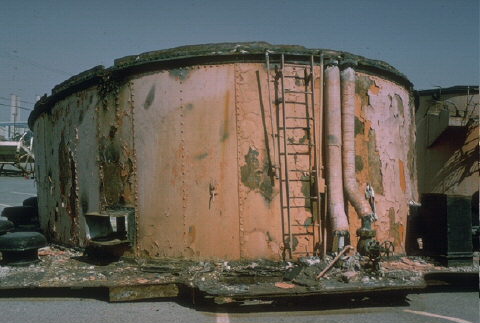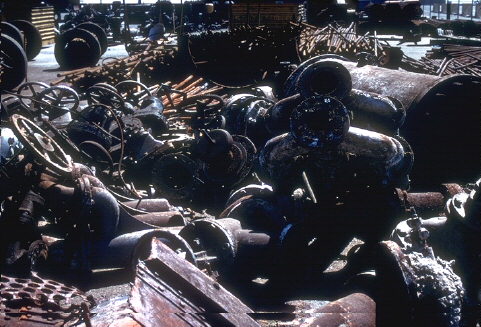
After the hull was painted underneath, the ship was removed from the drydock. It had been decided to clear almost every area of the ship below R deck to make way for the museum. This would take the new museum space to 400,000 square feet. It would mean the removal of all the ship's boiler rooms, the forward engine room, both turbo-generator rooms, and the water softening plant. Only the aft-engine room and "shaft-alley", right at the stern of the ship, would be spared from the cutter's torch.
The devastation was incredible. The Queen Mary's funnels (stacks) were removed and crumbled as they were lowered onto the quayside. They were replaced with new ones (notice today they have no rivets).

The funnels are removed from the ship. The Queen Mary has still not been repainted since her drydocking.

Some pieces of the funnels collapsed on removal. The paint on them was about as thick as the metal.
So much work had to be done inside the ship that a bulldozer was lowered into the boiler rooms to help clear some of the debris. All the scrap metal was dumped next to the ship in a huge pile. Turbines along with boilers and condensers, propeller shafts next to bits of bulkheads.

A stripped boiler room before the opening above was sealed.

The peak of technology in 1936 became just more scrap metal in 1968. Even then some thought that rather than creating space for a museum on board, they were destroying a perfectly good one.

Here, part of a steam turbine from the forward engine room lies next to its reduction gear.
It is probably true that a lot areas were cleared because they contained valuable scrap metal, particularly copper from the electrical circuits. Those visitors to this site who have seen the ship today will know the enormous empty spaces that were left after the ripout phase which never ended up being used for anything. As well as the engineering spaces, the Third class cabins were all destroyed, and they only indications that they were where they used to be now are the patterns in the flooring which is original. The area is used for storage today. The Second Class and Third Class restaurants went, as did the annexe to the First Class swimming pool, the Turkish Baths. The Second Class swimming pool was completely removed and offices put in its place. There is not a single crew cabin left intact abord the ship today.
By the time this phase was finished, almost everything below R Deck was destroyed. 18,000,000 pounds of drilling mud was put into the double bottom of the ship to attempt to give her some stability. 8,000 tons of machinery had been removed.
One of the subcontractors wrote about the operation:
"I worked on the QM during the conversion, for the air conditioning subcontractor as a matter of fact. Our superintendent, Beryl Kollinger, was as infatuated with the ship as anyone who ever sailed on her. He studied the ship's "geography" as well as every piece of wood and steel and rivets that held her together. He knew all the processes for the paneling and the brass, and I think was even better at giving tours to "visiting dignitaries" than any tour guide I ever saw,because of his love for the ship and concern for as much preservation as possible.
Within the parameters handed down from the City and the Cousteau group through the contractor (Smith-Amelco), he ensured that as great pains as were possible were taken by our sheet metal crew in installing the ductwork for the air conditioning, and any crew member who failed to show the proper respect for any area we were working in was sent back to the union hall, pronto.
We were all sick that the engine rooms were decimated, but it was totally out of our control. The plans for the museum changed almost weekly, as ideas Cousteau had designed (such as plexiglass handrails with eels swimming through them) were scrapped for one reason or another.
I was there when most of the equipment was removed through the stack spaces and onto the dock, and I wouldn't be surprised if much of the equipment was -- or ended up -- being too expensive to refurbish. I know one of the men who was involved in removing the lifeboats inadvertently put a foot through the rotten hull of one of them, so things were not in as good shape as they might have been.
I'm sure there was also the consideration of injury and liability (self-guided tours of an engine room might not have been the smartest idea), and they might have decided that most people wouldn't know one piece of engineering equipment from another, which is why the "engine room" was planned to be scaled down.
One of the engineers who remained on board to answer questions below decks was a
good friend of mine. Weight and stabilization were also considerations, as I recall, and I
remember many meetings about it and discussions in our office later on about the equipment
that had to come out and the methods they proposed to stabilize the ship, which was of
course a lot lighter when the equipment was removed. It may have been they had to remove
more equipment than they planned because of the different properties of the
"makeweight" and the need to keep it as immobile as possible. Like I said, I'm
not sure of all the technicalities, just a thought based on the few things I
remember".